In the fall of 1943, the eminent quantum physicist Niels Bohr managed a dramatic escape from occupied Denmark, arriving first in Sweden, then going to the United Kingdom. He was quickly assimilated into the British part of the Manhattan Project, then well underway. Bohr’s institute in Copenhagen had long been considered the world center of theoretical physics, and in the 1920s, young students from around the world flocked to work with him there. Now, in December 1943, Bohr and his son Aage made their pilgrimage to what was quickly becoming the new, stealth center of nuclear expertise: Los Alamos. At age 59, he would be the oldest scientist on “the Hill,” a place where the average age was 29.
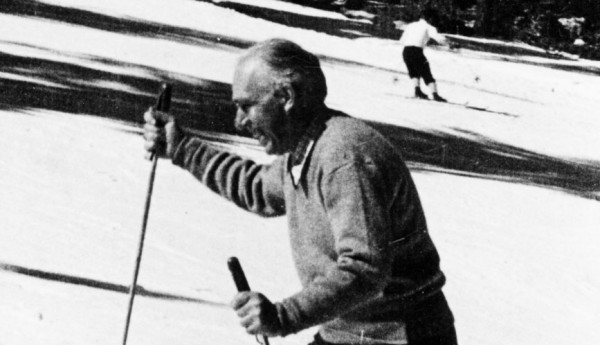
Bohr skiing at Los Alamos, January 1945, seemingly without a care in the world. Source: Emilio Segrè Visual Archives, Niels Bohr Library, American Institute of Physics.
This much is a standard part of Manhattan Project lore. Bohr’s contributions are usually spoken of primarily in psychological and moral terms. Bohr inspired the physicists to think about the consequences of their work, and laid the seeds of what would become the effort for postwar international control. He also spoke with both Churchill and Roosevelt, ineffectively, about the need to avoid an arms race. Bohr was a notoriously poor oral communicator, typically being barely audible. His deeply alienated and disturbed Churchill, who thought he might be proposing to tell the Soviets about the weapon. He probably just bored Roosevelt.
Some of the stories of his conduct at Los Alamos are adorably absent-minded. One of my favorite memos in the Manhattan Project archives is a February 1944 letter from Lt. Col. John Lansdale, head of MED security, to Richard Tolman, a physicist who was a good friend of the Bohrs. “Subject: Nicholas Baker,” it starts out, using Bohr’s wartime codename, and explains that in the process of following Bohr around, to make sure he was safe, some, well, deficiencies in his judgment were encountered:
“Both the father and son appear to be extremely absent-minded individuals, engrossed in themselves, and go about paying little attention to any external influences. As they did a great deal of walking, this Agent had occasion to spend considerable time behind them and observe that it was rare when either of them paid much attention to stop lights or signs, but proceeded on their way much the same as if they were walking in the wood. On one occasion, subjects proceeded across a busy intersection against the red light in a diagonal fashion, taking the longest route possible and one of greatest danger. The resourceful work of Agent Maiers in blocking out one half of the stream of automobile traffic with his car prevented their possible incurring serious injury in this instance.”
… I understand that the Bakers will be in Washington in the near future, at which time you will unquestionably see them. If the opportunity should present itself, I would appreciate a tactful suggestion from you to them that they should be more careful in traffic.1
Nobel-Prize winning physicist nearly run over by a car, because he treats American streets like paths in a forest, saved from disaster only by a trailing secret agent blocking the road with his car? You can’t make this stuff up. These kinds of stories reinforce the playful, harmless, “Uncle Nick” character that Bohr has come to represent in this period.
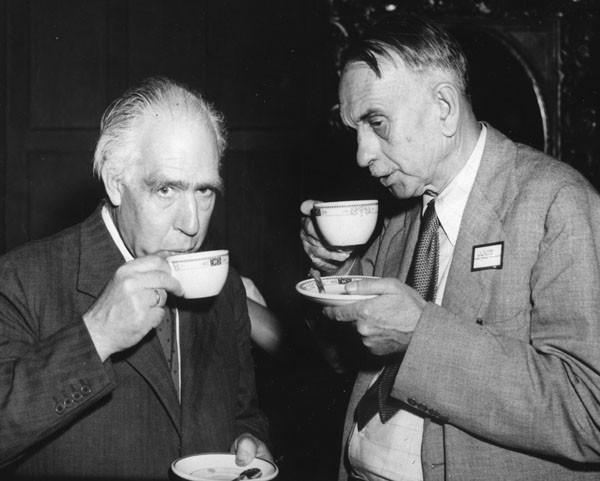
Bohr and General Groves’ personal technical advisor, Richard Tolman, attending the opening of the Bicentennial Conference on “The Future of Nuclear Science,” circa 1947. Source: Emilio Segrè Visual Archives, Niels Bohr Library, American Institute of Physics.
But the truth is a little more complicated. For his part, Bohr would later downplay his role in the actual creation of nuclear weapons. He told another physicist in 1950, for example, that he had spent most of his time while in the United States trying to forestall a nuclear arms race. “That is why I went to America… They didn’t need my help in making the atom bomb,” he later said.2
Did they need Bohr? Probably not — they probably would have managed well enough without him. But this is an odd standard for talking about one’s role in making a weapon of mass destruction. They didn’t need almost any individual who worked on the bomb, in the sense that they could have salvaged on without them.3
And not being “needed” does not really get one off the hook, does it? Which gets at what I think is a key point here: in the postwar, Bohr never relied on his contributions to the bomb as a means of claiming moral superiority, responsibility, or political leverage. He was active in attempts to promote international control and avoid an arms race, but he didn’t do so in a way that ever owned up to his own role in making the bomb. As a result, a lot of people seem to believe that Bohr didn’t really do that much at Los Alamos other than provide the aforementioned moral support and provocative questions.
In fact, Bohr did work on the bomb. And not just on esoteric aspects of the physics, either; one of his role was concerned with the very heart of the “Gadget.”
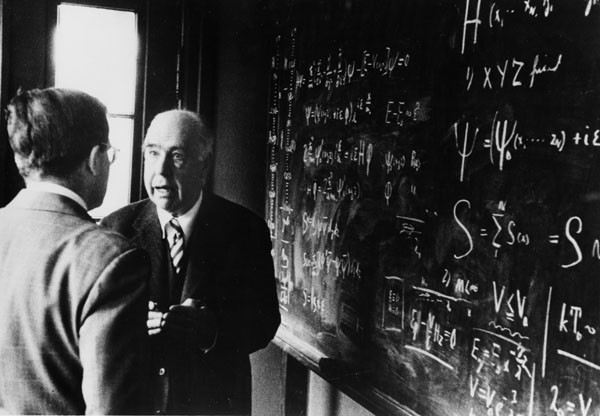
Niels Bohr (r) conversing animatedly with his son Aage in front of a board full of equations. Source: Emilio Segrè Visual Archives, Niels Bohr Library, American Institute of Physics.
One of the key parts of the implosion design for the atomic bomb (the same sort of bomb detonated at Trinity and over Nagasaki) is the neutron initiator that sits at the absolute center of the device. It is a deceptively tricky little contraption. At the instance of maximum compression, it needs to send out a small burst of neutrons, to get the whole chain reaction started. It’s not even that many neutrons, objectively speaking — on the order of a hundred or so in the first bombs. But conjuring up a hundred neutrons, at the center of an imploding nuclear assembly, at just the right moment, was a tricky technical problem, apparently.
The details are still classified-enough that figuring out exactly what the nature of the problem is proves a little tough in retrospect. In an interview many years later, the physicist Robert Bacher, head of G (Gadget) Division during the war, recalled that for whatever reason, Enrico Fermi had become particularly focused on the initiator as the lynchpin of the bomb, and maybe his own conscience:
I think Fermi began to be very worried about the fact that this terrific thing that he’d sort of been the father of was going to turn into a great big weapon. I think he was terribly worried about it. … I think he [Fermi] was worried about the whole project, not just the initiator. But focusing on the initiator was the one thing that he thought he could look at. The thing really might not work.
And I think he also felt an obligation to take something that was as hare-brained as this was and try to find a way in which it really wouldn’t work. So he did look into every sort of thing, and I think every second day or so for a period, I’d see him and he’d come up or he’d see Hans [Bethe] and come up with a new reason why the initiator wouldn’t work. …4
Bacher got sick of Fermi’s interference, and eventually went to Oppenheimer to complain. Bacher recalled:
I said, “What I’d like to do is, Uncle Nick is here now, and I’d like to go and explain to him about the initiator and say I’d like his advice and counsel on whether he thinks it will work or not. We’ll answer any question that he puts to us, that we know the answer to.” So we did and he agreed with us and I told him quite frankly, “One of the reasons that we want to do this is that Fermi has so many misgivings about initiators.”
So I talked to him for a long while and then he spent about two days with his son Aage going over every single thing that had been done on this business. I saw him after this and he said, “My that’s very impressive. I think that will work.” I said, “Well now comes the test. Will you talk to Fermi about this? The two of you talk together and give me some counsel of what’s up on this?” So he did. And it made a lot of difference to have Uncle Nick talk to Fermi, because he felt that this wasn’t somebody you had working on some particular model and so on. It was sort of somebody from the outside, and I think it made Fermi feel a lot happier. And it certainly made it a lot easier for us.5
The initiator that “Uncle Nick” convinced Fermi of, the one that they ended up using in the Trinity and Nagasaki bombs, was the “Urchin.”
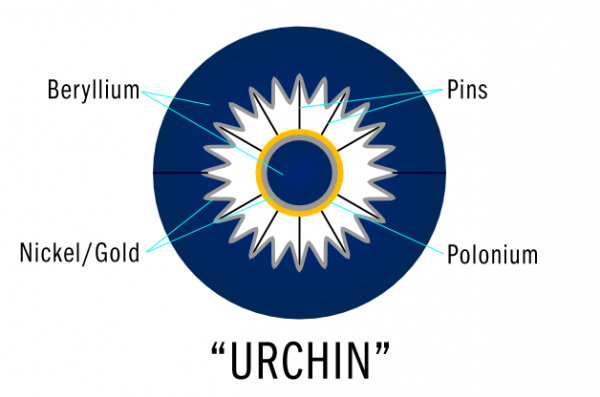
A schematic of the “Urchin,” as imagined by me, based on a postwar British account.
It was a hollow sphere of beryllium, a mere two centimeters in diameter. The inner side of the sphere was machined with grooves, facing inwards. At the center of these grooves was another sphere of beryllium, centered by pins embedded in the outer shell. On both the inner grooves of the outer shell, and the outer surface of the inner sphere were coated with nickel and gold. Onto the nickel of the inner sphere was a thin film of virulently radioactive polonium. Polonium emits alpha particles; in the non-detonated state of the “Urchin,” these would be absorbed harmlessly by the gold and nickel. But when the bomb came imploding in around it, the beryllium and polonium would be violently mixed, producing a well-known reaction (beryllium + an alpha particle = carbon + neutron) that produced the necessary neutrons.6
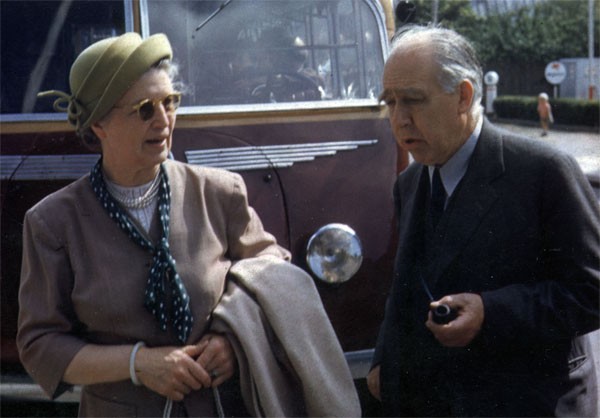
Margrethe and Niels Bohr converse in Copenhagen, 1947, in this extremely rare color photo. Source: Emilio Segrè Visual Archives, Niels Bohr Library, American Institute of Physics.
“Urchin” wasn’t the only initiator design on the table. Fermi apparently favored a design with the codename “Grape Nuts.” What was “Grape Nuts”? I have no idea — it’s still classified. Presumably these names meant something, since “Urchin” seems to reference the internal spikes. A topic listing for a May 1945 laboratory colloquium at Los Alamos discussed three initiator designs and their creators: “Urchin,” attributed to James Tuck and Hans Bethe; “Melon-Seed,” attributed to James Serduke; and, lastly, “Nichodemus,” attributed to… Nicholas Baker, the codename for Niels Bohr.7
In the recently-declassified Manhattan District History, there are several paragraphs on Bohr. Most of them describe theoretical work he did on the physics of nuclear fission after arriving at the lab, which “cleared up many questions that were left unanswered before.” His work affected their understanding the nuclear properties of tamper materials, and he apparently gave them ideas for “new and better methods… of alternative means of bomb assembly.” (All of which apparently just pointed to the superiority of implosion, in the end, but still.)
At least one sentence in the Manhattan District History is still completely blacked out. Maybe it refers to the initiator design (which the previous sentence refers to), maybe it refers to something else. It’s interesting that seven decades later, something of what Bohr worked on was still considered too classified to reproduce — evidence that Bohr’s influence on the bomb was less trivial than he would later make it out to be.8
Why does it matter? In Michael Frayn’s Copenhagen, there is, towards the end of the play, an implied asymmetry between Bohr and Heisenberg. Heisenberg is criticized throughout the play for potentially making an atomic bomb for Hitler. The play ultimately says Heisenberg didn’t make an atomic bomb in part because he wasn’t trying to make a bomb. (It does so with perhaps a little bit too much credence to the “he didn’t do it because he was sabotaging it thesis,” which I think there is no evidence for and no reason to believe, but anyway.) Driven by his fears, Bohr goes to the United States and actually does work on the bomb, does contribute to the killing of over a hundred thousand people, and so on. And so there is some irony there, where Heisenberg, supposedly the one in a state of moral jeopardy, is the one who actually contributes to the death of no one, where Bohr, supposedly the moral authority, is the one who helps build the bomb.
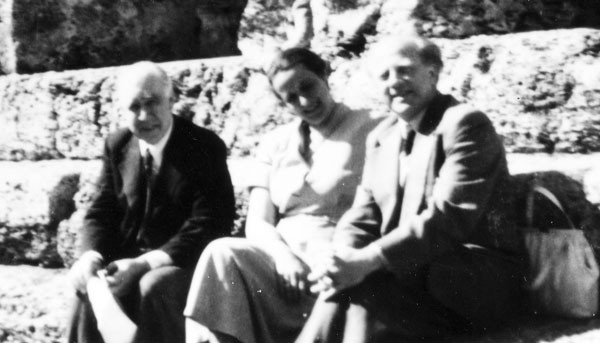
Bohr with Elisabeth and Werner Heisenberg in Athens, Greece, 1956. Source: Emilio Segrè Visual Archives, Niels Bohr Library, American Institute of Physics.
Do Bohr’s contributions to the atomic bomb, however major or minor, weaken his moral authority? I don’t really think so. Bohr’s strongest and most lasting contribution was putting the bug of international control into the heads of people like Oppenheimer. That bug might have come up on its own (when they learned about Bohr’s scheme, Vannevar Bush and James Conant were surprised to find that they had been thinking along almost exactly the same lines, completely independently), but Bohr’s influence on openness, candor, the moral obligation of scientists, and so on had a profound effect on postwar political discourse, even if his dreaded arms race was not avoided. In this light, I think Bohr still comes off pretty well, even if the bomb still does contain traces of his fingerprints.
- John Lansdale to Richard Tolman, “Subject: Nicholas Baker,” (5 February 1944), Manhattan Engineer District (MED) records, Records of the Army Corps of Engineers, RG 77, National Archives and Records Administration, College Park, MD, Box 64, “Security.” [↩]
- J. Rud Nielson, “Memories of Niels Bohr,” Physics Today 16, no. 10 (Oct. 1963), 28-29. [↩]
- I am occasionally drawn into a game of “who is so important that you absolutely couldn’t remove them and still expect it to be successful?” I am inclined to think that almost everyone would be more or less replaceable, as individuals, though there are a few whose contributions were so pivotal that removing them would create serious issues. Someday I will post some concrete thoughts on this on this. [↩]
- Robert Bacher interview with Lillian Hoddeson and Alison Kerr (30 July 1984), Robert Bacher papers, Caltech Institute Archives, Pasadena, CA, Box 48, Folder 5. [↩]
- Ibid. [↩]
- Accounts of the exact dimensions of the “Urchin” vary from source to source. John Coster-Mullen’s book, Atom Bombs, gives what I find to be convincing evidence that it was 0.8 in./2 cm in diameter. There was 20 curies of polonium deposited in them, and they had to be replaced frequently because of polonium’s low half-life. The inner core of the plutonium pit was about 1 in. in diameter, and apparently both the core and the initiator would be expected to expand slightly due to the heat generated by their radioactivity. Apparently James Tuck gave it the name “Urchin,” on account of its inner ridges. There is some question as to how the grooves were machined, whether they were pyramids (as in the British account) or ridges (e.g. like a theatre in the round). It’s always nice to be reminded that there are still a few secret details out there. [↩]
- The list of wartime colloquia comes from the Klaus Fuchs FBI File, Part 49 of 111, available on the FBI’s website, starting on page 49 of the PDF. The only other “Nicholas Baker” contribution mentioned in the document is a November 1944 talk on “nuclear reactions of heavy elements and particularly the various results obtained when a neutron comes in contact with heavy nuclei, such as Uranium 238.” [↩]
- Manhattan District History, Book 8 (Los Alamos Project), Volume 2 (Technical), pages II-2 to II-3. [↩]
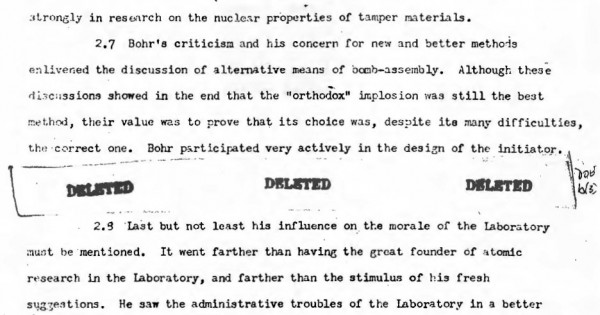



Terrific, as always, Alex. On the question of international control you bring up at the end, I have been much impressed by Waqar Zaidi’s work on the influence fairly well-known existing proposals for an “international air police” by “liberal internationalists.” These proposals seem to have translated fairly seamlessly into proposals for international control of atomic energy. The upshot is we don’t need to look so intently for the genesis of the idea among physicists, since the basic idea of internationally controlling apocalyptic technology was already current.
Interestingly, Churchill, in his iron curtain speech, rejected international control of atomic energy, but still supported the air police idea.
I posted about this several years ago here.
Interesting, the list of prominent scientists vying for the role in history as the “conscience” of their respective bomb programs. Politicians quickly realized that these weapons were strategic, their success measured by non-use. Churchill, Rosevelt, and Stalin instinctively understood this policy dimension, one that Utopian scientists like Bohr seemingly missed.
Today we have scientists and engineers working to create a new generation of nukes that will be more “useful” and escape the chains of strategic logic. Where are the consciences, the concerns in the U.S., Japan, China, Russia, Germany, etc., as these clandestine efforts move forward?
I like your imagined construction of the “urchin”. I’ve heard the codename “urchin” for the FM initiator forever, but never thought of its name to be so reflective of its construction. Having seen so, so many sea urchins while snorkeling the reefs of Hawaii, I think you’ve nailed it here.
Again, every post of yours is fascinating.
[…] Restricted Data: The Nuclear Secrecy Blog: What did Bohr do at Los Alomos? […]
Is there anything in the open literature that would indicate urchin had the spikes on the inner surface of the outer shell? both from the name, and machining etc it would seem like it would be easier to machine the spikes on the outside of the inner sphere. As always wonderful writing, and thank you for talking about this in a way that a layman like myself can understand. Nuclear history is an interesting thing, and one that people seem dedicated to hide sometimes.
James S.
Everything I’ve seen (which has all been “open”) says there are some kinds of internal spikes, or ridges, or grooves. To quotes from a 1947 British document: “The serrations on the inner surface convert the shock wave into a multitude of jet actions which thus ensure complete shattering and mixture of the two elements, thus causing neutron emission.” Which is scientist-talk for saying that they shatter inward and guarantee that the beryllium and the polonium will get extremely mixed up. If it was perfectly smooth, there would be a risk that it would just compact as opposed to mix.
Ah, that makes sense, I was thinking having the ridges on the inner sphere made sense, but by putting them on the outer sphere they are given the push earlier and can mix better. THank you
James
Machining spikes on the inner diameter of non-radioactive beryllium would seem to me to be infinitely easier than trying to that same work on HIGHLY radioactive polonium…
I suspect that the “jet actions” were created by the collapsing serrations via the Munroe effect encountered in shaped charges.